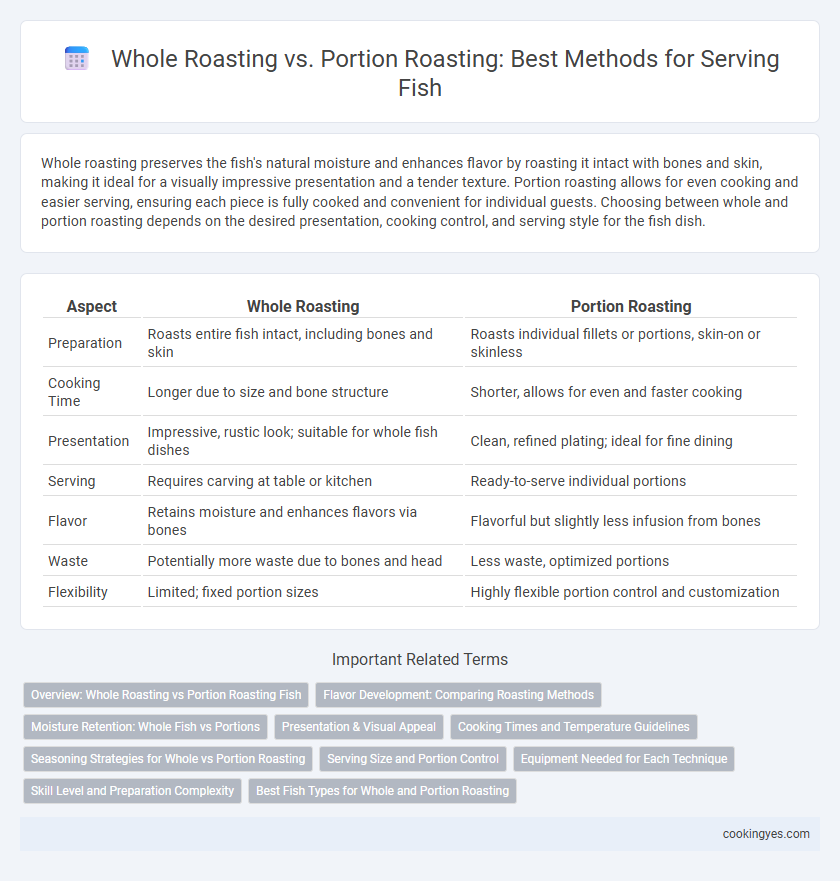Whole roasting preserves the fish's natural moisture and enhances flavor by roasting it intact with bones and skin, making it ideal for a visually impressive presentation and a tender texture. Portion roasting allows for even cooking and easier serving, ensuring each piece is fully cooked and convenient for individual guests. Choosing between whole and portion roasting depends on the desired presentation, cooking control, and serving style for the fish dish.
Table of Comparison
| Aspect | Whole Roasting | Portion Roasting |
|---|---|---|
| Preparation | Roasts entire fish intact, including bones and skin | Roasts individual fillets or portions, skin-on or skinless |
| Cooking Time | Longer due to size and bone structure | Shorter, allows for even and faster cooking |
| Presentation | Impressive, rustic look; suitable for whole fish dishes | Clean, refined plating; ideal for fine dining |
| Serving | Requires carving at table or kitchen | Ready-to-serve individual portions |
| Flavor | Retains moisture and enhances flavors via bones | Flavorful but slightly less infusion from bones |
| Waste | Potentially more waste due to bones and head | Less waste, optimized portions |
| Flexibility | Limited; fixed portion sizes | Highly flexible portion control and customization |
Overview: Whole Roasting vs Portion Roasting Fish
Whole roasting fish preserves moisture and enhances natural flavors, ideal for presenting a visually impressive dish. Portion roasting allows for faster cooking and easier portion control, making it practical for individual servings and diverse seasoning. Selecting between whole or portion roasting depends on serving style, cooking time, and presentation preferences.
Flavor Development: Comparing Roasting Methods
Whole roasting enhances flavor development by allowing the fish's natural oils and juices to circulate, resulting in a moist, tender texture with intensified taste. Portion roasting exposes more surface area, promoting caramelization and a crispier exterior while offering quicker cooking times. Both methods impact flavor, but whole roasting maximizes depth, and portion roasting emphasizes texture contrast.
Moisture Retention: Whole Fish vs Portions
Whole fish roasting preserves moisture more effectively than portion roasting due to the intact skin and bones, which act as natural barriers against dehydration. Portion roasting exposes more surface area, increasing moisture loss and resulting in a drier texture. This difference in moisture retention significantly impacts the juiciness and overall flavor quality in fish dishes.
Presentation & Visual Appeal
Whole roasting fish preserves its natural shape and scales, offering an impressive, rustic presentation that highlights the fish's freshness and size. Portion roasting creates uniform, manageable pieces that are easier to plate artistically and cater to individual servings, enhancing visual appeal through neat, consistent plating. Choosing between whole or portion roasting depends on the desired dining experience, balancing dramatic presentation with refined, elegant service.
Cooking Times and Temperature Guidelines
Whole roasting a fish typically requires longer cooking times at moderate temperatures, around 350degF (175degC) for 20 minutes per pound, ensuring even heat penetration and moist texture. Portion roasting involves shorter cooking times, usually 10-15 minutes at higher temperatures near 400degF (200degC), allowing for faster cooking and crispier edges. Adjusting time and temperature based on fish thickness and type optimizes flavor and texture in both methods.
Seasoning Strategies for Whole vs Portion Roasting
Whole roasting fish benefits from robust seasoning techniques that penetrate deeply, such as stuffing with aromatic herbs like dill, thyme, and garlic, ensuring flavors infuse throughout the flesh. Portion roasting allows for more precise seasoning control, often using marinades or spice rubs tailored to individual cuts, enhancing flavor without overpowering the delicate texture. Both methods leverage acid-based elements like lemon juice or vinegar to balance richness, but whole roasting demands a more uniform seasoning approach to achieve consistent taste.
Serving Size and Portion Control
Whole roasting fish preserves its natural moisture and flavors while allowing for visually impressive presentation, but portion control can be challenging due to varying sizes and thickness of the fish. Portion roasting fish fillets ensures consistent serving sizes, making it easier to manage nutritional content and streamline plating in a restaurant setting. Selecting between whole and portion roasting impacts serving efficiency and waste reduction, critical factors in catering and foodservice operations.
Equipment Needed for Each Technique
Whole roasting fish requires a large roasting pan or fish roaster, a sturdy rack to hold the fish evenly, and a reliable oven or grill with consistent heat distribution. Portion roasting demands smaller baking sheets or individual roasting trays, precise temperature control equipment, and often a broiler or convection oven for even, quick cooking of smaller fish segments. Both techniques benefit from the use of a meat thermometer to ensure optimal internal temperature and prevent overcooking.
Skill Level and Preparation Complexity
Whole roasting fish requires advanced skill levels due to the need for precise temperature control and thorough cleaning to ensure even cooking and enhanced flavor. Portion roasting is less complex, suitable for intermediate cooks, as it involves smaller pieces that cook faster and allow for easier seasoning and presentation. Choosing between whole and portion roasting depends on the chef's experience and desired preparation time, impacting texture and taste consistency.
Best Fish Types for Whole and Portion Roasting
Whole roasting suits larger fish such as salmon, sea bass, and trout, preserving moisture and intensifying natural flavors through even cooking. Portion roasting works well with firm, flaky fish like cod, halibut, and snapper, allowing precise control over doneness and serving sizes. Selecting the fish type based on texture and size enhances roasting outcomes and presentation quality.
Whole roasting vs portion roasting for serving fish Infographic

 cookingyes.com
cookingyes.com